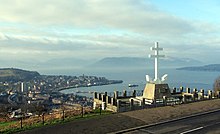Lyle Hill

Lyle Hill is a viewpoint in Greenock, Inverclyde, Scotland.



Providing a panoramic view across the Clyde, its highest point is 426 feet (130 m) above sea level. It overlooks Gourock and the Tail of the Bank, an area of the River Clyde named after the end of the long sandbanks resulting from the river`s journey from the counties of Lanark and Renfrew and denoting the point at which the river becomes the Firth of Clyde. Also visible are the Cowal hills, with the town of Dunoon below, the Holy Loch, former site of the US Navy Scottish submarine base and the settlements of Kilcreggan, Rosneath and Helensburgh to the east. On a clear day it is possible to see beyond the Erskine Bridge to Glasgow in the east, and the Island of Arran and beyond to the south west.
Immediately to the north of the hill Greenock's Battery Park formed from landfill at the time of railway construction provides level playing fields, bounded on the west by Gourock's Cardwell Bay and on the east by the former torpedo factory, now occupied by warehousing and a housing development, and the Navy Buildings for long occupied by HM Coastguard. They stand at Ironotter Point which in the late 18th century was the site of a coastal gun battery called Fort Matilda, a name now given to the area, to the railway station just to the north of Lyle Hill and to the playing pitch of the local rugby side, the Greenock Wanderers.
The viewpoint is marked by a beacon which was constructed to mark the Silver Jubilee of Queen Elizabeth in 1977 and is lit on special occasions. There is also a view indicator on Craigs' Top, the highest point of the hill. While there are steep crags on the north and west of the hill, formed by glacial erosion, the southern slopes are gentler and form the site of Greenock golf course.
A war memorial to the Free French forces who fought in the Second World War stands on the western brow of the hill. It was built in the shape of the Cross of Lorraine, the emblem of the Free French, combined with an anchor.
The name Lyle has local connections, most prominently Abram Lyle, born in 1820, who founded the sugar refining company which merged with a rival in 1920 to form Tate & Lyle, and was Provost of Greenock from 1876 to 1879. However the name of the hill predates his successes, as it appears as Lyle's Hill in James Knox's Map of the Basin of the Clyde of 1836.[1]
